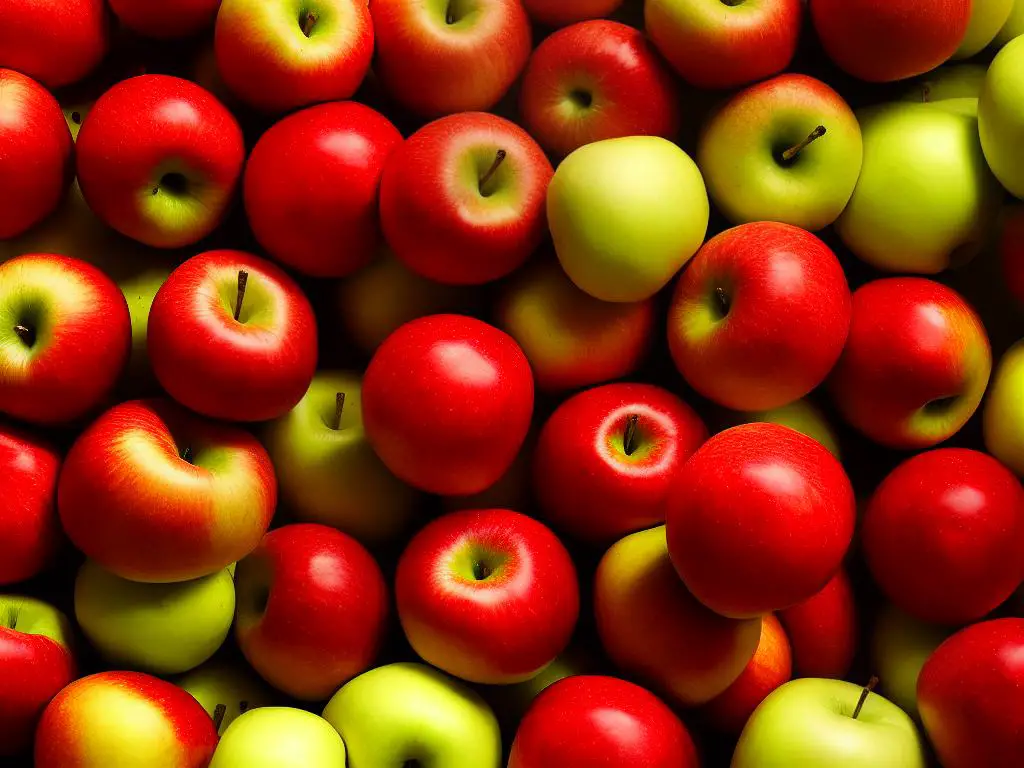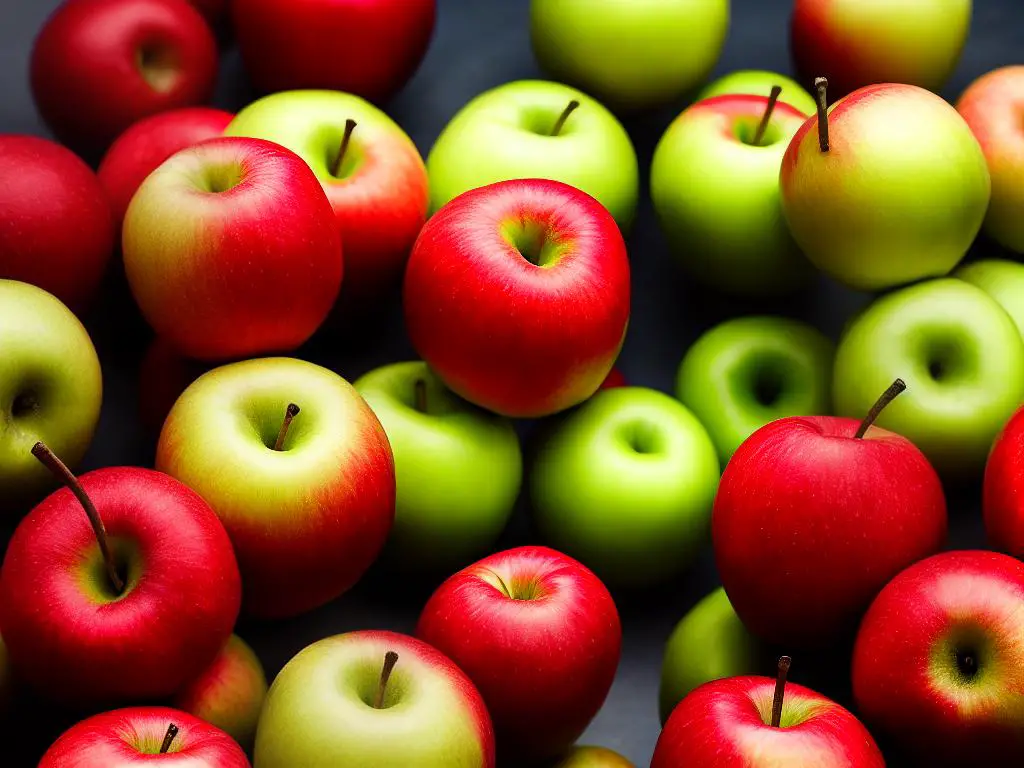There is a magic captured in the varieties of apples that we consume, a story that unfurls with each tasty bite. Some stories are of legend, others of heritage, and some peculiar to the taste buds. The Acey Mac apple, with its blend of crispness, sweetness, and tartness, carries such a tale. This piece will not only peel away the layers of the tale but will also provide an in-depth examination of the characteristics that make this apple variety a favorite among many. Going beyond the surface, we’ll traverse through the best practices for growing this variety, guiding both novice and seasoned growers through the process of planting, caring, and even protecting this apple type. Lastly, we’ll discuss the tell-tale signs of a ripe Acey Mac apple, the know-how surrounding harvest, and the secrets of storing them to retain their quality.
History and Characteristics of Acey Mac Apples
The History of Acey Mac Apples
Acey Mac Apples, also known as “Massee” or simply “Acey Mac,” have quite an intriguing history. They belong to the species Malus domestica and are a variant of the famous McIntosh apples. The Acey Mac apple has its origins in North America, particularly New York State. Acey Mac was discovered in the 1920s by a man named Cecil F. Massie, hence the original name “Massee.” Massie found this variety in his orchard in Peru, New York on a McIntosh tree. Since Massie preferred the name Acey (a combination of his initials A.C.), “Massee” evolved into “Acey Mac.”
Characteristics of Acey Mac Apples
Acey Mac apples are known for their vivid color and distinctive taste. They have a beautiful appearance, with a strikingly red skin covering the majority of the apple’s exterior, sprinkled with a few streaks of green. Their flesh is remarkably crisp and white. However, what sets them apart from other apple varieties isn’t just their appearance, but their taste and aroma as well.
Acey Mac apples have a unique sweet, tart flavor with a hint of spice that’s not too overpowering. Their distinctive tartness is reminiscent of the McIntosh, yet they’re generally sweeter. Moreover, they produce an intoxicatingly fragrant aroma, which is just one more reason they’re favored among apple lovers.
Popularity and Uses of Acey Mac Apples
The balanced sweet-tart taste of Acey Mac apples makes them a versatile option for various culinary uses. They’re excellent for fresh eating, i.e., consuming raw due to their juicy, crisp texture. They’re also an excellent choice for baking – their firm flesh holds up nicely when baked, making them perfect for pies and other baked desserts.
In addition to these uses, Acey Mac apples are also commonly used for making applesauce. When cooked, they break down easily and quickly, producing an excellent texture for sauces. However, their tart flavor becomes more pronounced upon cooking, so it’s recommended to balance it with sweetener as per taste.
The Significance of Acey Mac Apples Within the Landscape of Apple Varieties
Despite not having the same commercial prominence or recognition as its parent, the McIntosh, the Acey Mac apple has carved out a niche of its own in the realm of apple variants. With its balanced sweetness and tartness, superior texture for both cooking and raw consumption, and unique fragrant aroma, this apple has endeared itself to enthusiasts and hobbyists alike.
In a market that continually sees the introduction of new apple varieties, the Acey Mac apple’s consistent fanbase attests to its enduring charm. This signifies the value of diversity among apple varieties, each with its own standout physical attributes, flavor profiles, and application range.
As a testament of the regional impacts of apple cultivation, Acey Mac apples emphasize the allure of season-specific, geographically unique apple varieties even in our globally connected world. They serve as a testament to the intricate influence of distinct regional climates on apple characteristics, enriching the variety spectrum available to apple connoisseurs. Their story assures the ever-present space for specialty varieties in the grand array of apple variants, proving that variety indeed enriches the apple lovers’ experience.

Cultivation Practices for Acey Mac Apples
Delving into the Cultivation of Acey Mac Apples
Belonging to the McIntosh lineage, Acey Mac apples are renowned for their delicate, succulent pulp, and a harmony of sweet and tart flavor that makes them a top choice for fresh consumption, baking, as well as cider production. Just like any other apple variant, the cultivation of Acey Macs demands detailed attention towards correct planting techniques, fitting climatic conditions, suitable soil types, and regular care to ensure abundant, healthy crops.
Climate and Soil Requirements
Acey Mac apple trees prefer a moderate climate with cold winters and mild summers. These conditions are essential to ensure the trees complete their necessary dormancy period and to prevent the blossoms from opening too early. They can tolerate temperatures as low as -40 degrees Fahrenheit during dormancy. The trees need full sun exposure, at least six hours a day, to fruit well.
As for soil, Acey Mac trees thrive best in deep, well-drained, loamy soil with a pH ranging between 6.0 to 7.0. However, they can tolerate a wide variety of soil types, including sandy and clay soils, as long as they are well-drained to prevent root rot and other water-related diseases.
Planting Techniques
Planting Acey Mac apple trees properly is vital to their survival and productivity. The best time to plant these trees is in early spring, as soon as the soil can be worked. When selecting the planting site, ensure it’s spacious enough to accommodate the tree’s mature size and free from frost pockets. Dig a hole twice as wide as the root ball, but no deeper. The top of the root ball should be level with or slightly above the ground surface. After placing the tree in the hole, backfill it with soil, ensuring no air pockets are left.
Pruning, Watering, and Fertilization
Prune Acey Mac apple trees every winter during dormancy to promote better light penetration and air circulation in the canopy. Remove any dead, damaged, or diseased branches, as well as any crossing or vertically growing limbs.
Water your Acey Mac apple tree regularly, providing about an inch of water per week. However, be careful not to overwater as this may lead to root diseases.
To promote a healthy growth, fertilize your Acey Mac apple tree in late winter or early spring before bud break. A balanced granular fertilizer is recommended. Annual soil testing will help you determine the nutrient needs of your plants.
Disease and Pest Management
Acey Mac apple trees are susceptible to several diseases including apple scab, powdery mildew, and fire blight. Regular preventative sprays with appropriate fungicides or bactericides will help control these diseases.
Common pests affecting Acey Macs include apple maggot, codling moth, and aphids. Introducing beneficial insects such as lady beetles and lacewings, or using pheromone traps and insecticides can help manage these pests.
Final Thoughts
Nurturing Acey Mac apple trees and watching them grow can bring immense satisfaction. Successful cultivation comes from considering factors like the right climate and soil, adopting correct planting methods, and maintaining routine care like pruning, watering, and fertilizing. Each of these elements plays a crucial role in the tree’s health and productivity. Effective management of any pest or disease threats is also a crucial part of this process to ensure a plentiful and high-quality harvest. Every correct step in this journey amplifies the joy of seeing your Acey Mac apple tree thrive and bear fruit.

Harvesting and Storage of Acey Mac Apples
Getting to Know Acey Mac Apples
‘Acey Mac’ or Malus domestica ‘Acey Mac’ apples, are an endearing variety deeply ingrained in America’s apple culture, initially sparked off in New York State. These apples, with their pronounced flavor and radiant red skin, have become a favorite. Being an early-season variety, Acey Mac apples usually reach ripeness by early September. But being aware of the optimal harvesting period and the right storage techniques can extend your enjoyment of this deliciously sweet apple to its maximum potential.
Identifying Ripe Acey Mac Apples
Knowing when an Acey Mac apple is ripe and ready for harvest may not be as straightforward as with other apple varieties. Unlike some apple types, the Acey Macs do not automatically fall off the tree when ripe. Therefore, it is important to look for other ripeness indicators. Ripe Acey Mac apples are usually medium to large in size and primarily red, though they may carry some yellow or green undertones.
The best indicator of ripeness is the apple’s flavor. When you suspect the apples are nearly ripe, pick one and taste it. If the apple tastes sweet and is juicy, then it’s a good sign that the apple is ready for harvest. Additionally, another ripeness sign could be the presence of a few fallen apples underneath the tree. This usually indicates the apples are fully ripened.
Proper Harvesting Techniques
Care must be taken during the harvesting process to ensure you don’t damage the Acey Mac apples. Instead of pulling the apple off the tree, turn the apple upside down and twist gently. If the apple is ripe, it will easily release from the tree. Be careful to avoid bruising the apples during harvesting as this not only affects their storage life but also their quality.
Long-Lasting Storage Methods
For the Acey Mac apples to last for a prolonged period after harvesting, appropriate storage methods should be implemented. Ideally, store the apples in a cool, dark place with good air circulation. Basements, cellars, or specialized fruit storage boxes are excellent choices. For maximum freshness, the apples should be stored at a temperature of around 30-32 °F with 90-95% humidity.
Wrapping each apple in newspaper or packing paper can further help to prevent bruising and damage. It is also recommended to check the apples regularly during storage and remove any that show signs of rot or disease, to prevent the condition from spreading to the other apples.
Conclusion on Harvesting and Storage of Acey Mac Apples
Harvesting and storing Acey Mac apples doesn’t need to be a daunting task. By knowing what signs to look for in ripeness, mastering the correct harvesting technique, and implementing effective storage methods, you can enjoy these tasty delights for an extended period. Embracing these methods will help to preserve the freshness, crispness, and flavorful nature of the Acey Mac apples, making the entire process fruitful and rewarding. Remember, it’s all about patience, care, and consistency. Happy harvesting!

Undeniably, the Acey Mac apple is more than just an ordinary fruit; it’s a wonder molded by time, skill, and knowledge. A rich blend of the right conditions, proper care, and timely harvest can transform an insignificant seed into a marvel that delights the palate. This journey through the life of an Acey Mac apple—from the time it’s a seedling till it becomes a beautiful, crisp apple—reveals a tale of dedication and passion. Equipped with this newfound knowledge, when you bite into your next Acey Mac apple, it’ll be much more than mere taste you experience. Every crunch will resonate with the stories of its origin, the efforts in its cultivation and the careful harvest that brought it to your plate. An Acey Mac is not just an apple; it’s a tangible tale of resilience, nurturing, and the victory of a harvest well done.